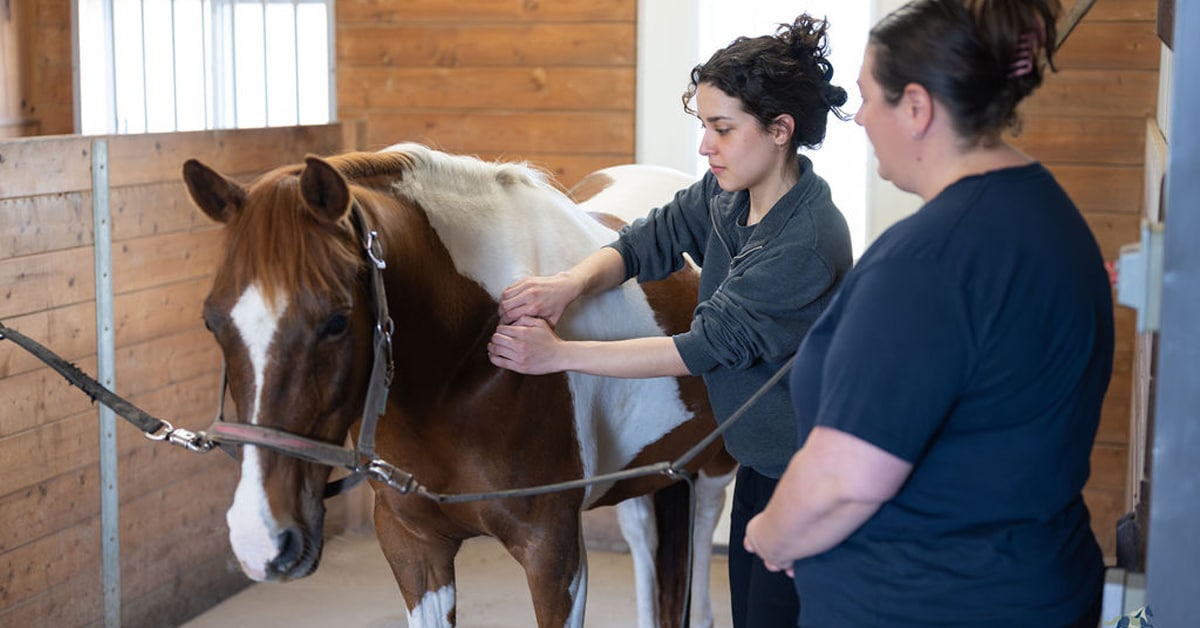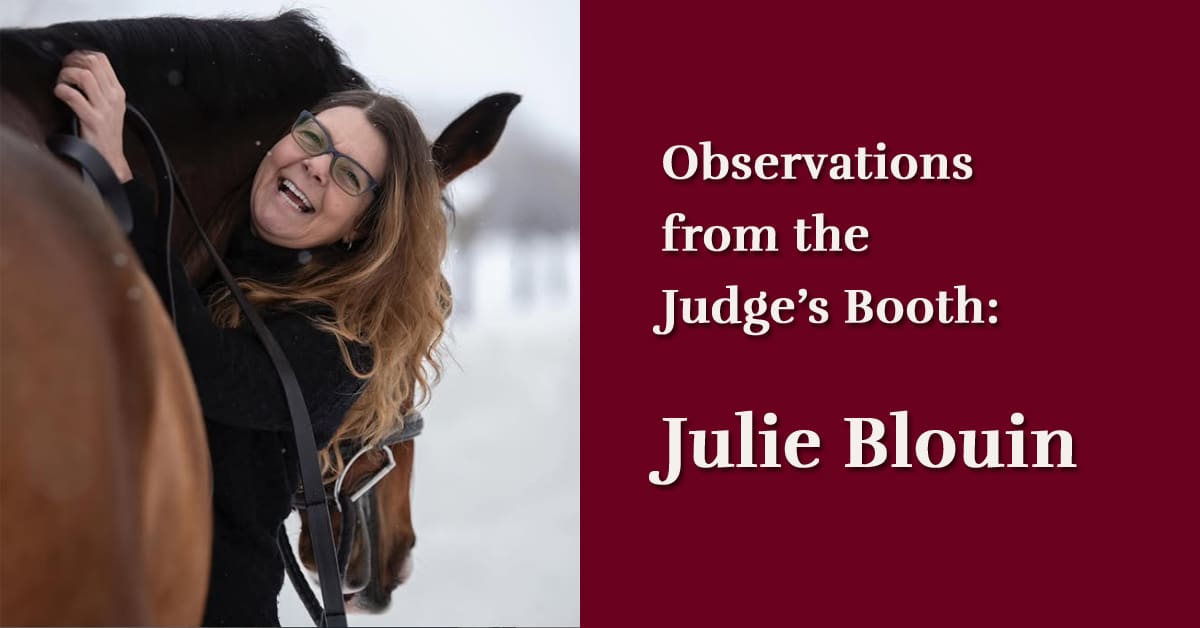The OEF has had a rough ride over the last year. Former executive director Dianne Graham left under undisclosed circumstances, four board members resigned, and there have been rumours of financial difficulties. In addition, the Ontario Ministry of Tourism, Culture and Sport (OMTCS) that recognizes the OEF as the official provincial equestrian organization and provides important funding, advised the organization that it needed to do more to support its athletes through training and coaching programs to maintain its status with the Ministry.
To replace Graham, the remaining board members hired Dominique Bosshart as the new executive director. Interestingly, Bosshart was the sport development manager for Taekwondo Canada, the same sport that Equestrian Canada’s CEO, Eva Havaris, also left. In her new role, Bosshart is charged with making major changes to the organization so that it better serves members and is compliant with Ministry requirements. To that end, the OEF released its new strategic plan, dubbed #LeadChange, which outlines the new organizational structure and the guiding principles that will drive decision-making, resource allocation, and activities until 2020.
Structural changes
A big part of the restructuring included updating the by-laws, which were approved at a special meeting at the beginning of June. “There were some very specific things that the OEF needed to do in order to maintain that compliancy,” explained Bosshart. “It became very clear in the recent past that there were things that needed to change and a big part of that was the bylaw, the governance model, in order to be aligned with the Ontario not-for-profit [framework].”
Among other smaller items, the new by-laws feature three key changes:
1) Eliminating the five advisory councils. The councils for Associations, Competitions, Industry, Horse Facilities, and Recreation were previously appointed positions and have been removed in favour of creating democratically-elected board positions in line with not-for-profit requirements.
2) Reducing the number of board members. The old by-laws called for 14 directors, a number which is generally accepted as too large a group to communicate with and get concensus from in order to drive the organization’s mandate. The new by-laws will have the board shrink to nine directors by the 2018 Annual Meeting.
3) Changing the term limits. Previously, directors were elected for a two-year term and could serve a maximum of five consecutive terms (10 years total), but now directors will serve a three-year term with a maximum of two consecutive terms (or six years total). This shorter time frame ensures that more people will be part of the board, sharing their unique experiences and different ideas.
Another major part of the structural changes included trimming seven staff members in April in an effort to keep costs under control. “Resources, human and financial, had to be really focused on the programs vs. on the marketing magazine,” noted Bosshart. “The reorganization had nothing to do with the people themselves; it strictly had to do with the need for focus on programs.”
Many of the positions that were eliminated were related to producing the OEF’s magazine, Whoa, which ceased publication as of this spring and has been replaced by a more cost-efficient e-newsletter. The significant savings will be used to refocus efforts to sport-related programs.
Sporting changes
One of the most ambitious changes at the OEF centers around developing more programs for athletes who are striving for high-performance competition.
While Equestrian Canada (EC) provides some coaching and financial support for those competing at the Young Rider level and beyond, under government guidelines the provinces are responsible for developing athletes up to that point. Currently, the OEF oversees the English Rider Levels 1 through 10 (and Western Rider levels 1-4) at the end of which a rider is expected to have sound knowledge and experience training horses capable of competing at EC silver and gold levels and can jump a course of maximum 3 ft (90 cm).
There is an enormous difference, however, between jumping a 3-ft course and being able to compete at Young Riders, but the OEF is going to attempt to fill that. “The OEF doesn’t have programming to fill the gap between Rider Level 10 and the Young Riders competition,” said Pam Coburn, Coaching and Stables program manager. “We are consulting with different disciplines to develop a strategy to fill that void and to coordinate resources to better support athletes.”
Developing these programs is going to be an extremely difficult task in an industry that has had no such oversight or structure to this point. “The industry needs to create globally-relevant competition streams for kids that are tracked by age,” suggests Scott Walker, an Ontario-based A circuit hunter/jumper coach. “In hockey or soccer, if you are at a certain age you must move up a level or switch to a house league. But there are no incentives for kids to do that in show jumping, and quite a few financial barriers.”
“The Rider Levels test more basic horsemanship skills, rather than being targeted for high performance,” noted Kelly Plitz, an Olympic eventer and Level 3 EC coach. “The problem is that the FEI level is at a different standard than the national level.”
Both Walker and Plitz stressed the need for the sport to offer suitable competitions to better prepare riders. “There are still lots of events out there that will qualify a rider to compete at the FEI level, but won’t give them the experience and doesn’t make them ready or properly prepared to compete at that level,” said Plitz. “We need a national progressive system that offers incentives for riders to move-up and more coaches to encourage riders to follow that path,” added Walker.
Ontario does have one initiative in the works to support junior athletes. Quest For Gold is a program funded by the Government of Ontario through the Ministry of Health Promotion and Sport that was started in 2010. While the program is not available to OEF members in 2015/2016, plans are in the works. “The decision was made to use this year to develop new criteria for the allocation for Quest For Gold cards,” says Bosshart. “We will be participating in Quest For Gold in the upcoming year. The details for the program are not yet available, but will be made accessible on our website.”
Recreational riders
The OEF is quick to point out that while it’s increasing its sport focus, it will continue to build on the programs offered to recreational riders, which represent almost 70% of OEF members. “The new direction is one that establishes practices that provide improved programs and systems for all riders/drivers,” says Bosshart, even those who have no desire to compete.
One popular program that has been around for more than 20 years is Ride Ontario, where riders and drivers earn rewards as they accumulate time and kilometers riding or driving. New applications into the program have been suspended for 2016 as the OEF re-evaluated to make it more interactive for 2017. “We think that it has potential to be something more people could engage in,” says Bosshart. “We need to really look at that and what makes the most sense. Right now we are honouring anybody who is currently in that program and we will track their hours.”
Grassroots
The OEF continues to offer some programs at the grassroots level aimed at increasing participation in equestrian activities.
The Facilities Program is strictly voluntary and includes stables that agree to keep their property in good condition, make safety a top priority in their riding programs, and ensure their horses and ponies are in good health and are suitable for use in riding lessons. The objective is to provide a minimum standard at all riding schools and boarding stables across the province including insurance, emergency action plans, waivers, horse welfare, barn rules, and eventually certified coaches. By the end of 2015 there were 168 accredited facilities in the program. “Over this summer, we will be working to bring the total number of accredited stables to approximately 180,” says Bosshart, “and the aim is to have a total of 200 signed up for 2017.”
There are currently no on-site inspections for facilities. “The accreditation program is incentive-based,” says Bosshart. “Our focus is to work with those accredited facilities as partners in the community to deliver equestrian programming. By building those relationships, we hope to encourage non-accredited facilities to engage in the program and commit to maintaining their stable operations. We will develop policy that will deal with issues that arise from time to time – complaints, questions, etc.”
To encourage new riders to visit accredited farms, the OEF offers the Ticket to Ride program. Participating English and Western riding facilities offer a free assessment lesson, a discounted lesson package, or free “introduction to horses” barn tour. “This is one way to connect the public directly to an opportunity to get into horseback riding,” says Bosshart of the program that the OEF promotes at Cam Am Equine and the Royal Winter Fair, and is available year-round on their website.
Increased efforts will also centre around getting more OEF-accredited stables to participate in EC’s national Horse Day, an initiative aimed at connecting people to the local stables in their communities. Of 168 OEF-accredited facilities, only 14 participated this year (up from 6 in 2015). The OEF is going to look at building networks between barns and associations to deliver more interesting and entertaining packages.
A good start … but a long way to go
Getting the OEF organized in such a way that it is able to operate efficiently and focus on core tasks that will improve the industry was a necessary first step to improve the provincial industry.
“We seem to be very quickly getting through house-keeping issues and will be able to get to the business of developing sport,” said OEF president Marc Nelson. “It’s why I signed on in the first place, so I’m excited about that.”
The real test, however, will lie in getting an entire industry that was purpose-built as needs arose to change into a more efficient and effective model. Such a transformation will require massive changes to how riders are taught and guided through the system that will also require equally significant changes at the national level in order to have a chance of being effective, or even plausible.
The real test, however, will lie in getting an entire industry that was purpose-built as needs arose to change into a more efficient and effective model.
The Latest









